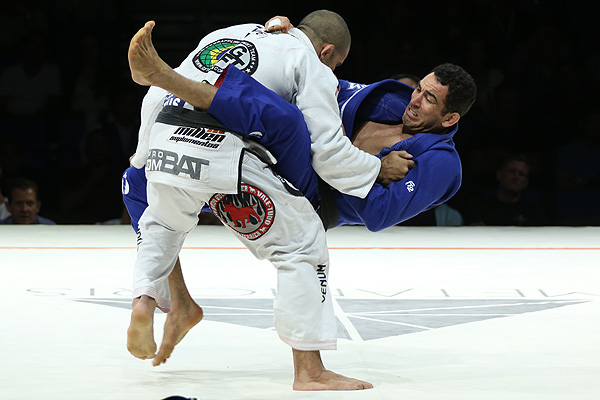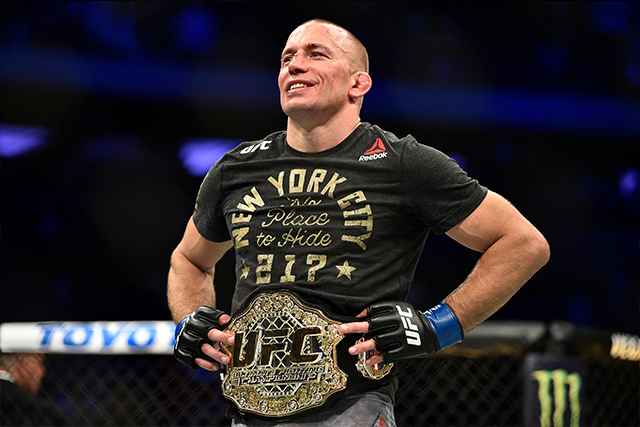Brazilian Jiu-Jitsu and the Middle Ages
Competitive Pursuits

At least one of my middle-aged teammates took his cue from Tyler Durden. As we sat by the mats watching several guys go at it, James Gustin, a 48-year-old, silver-haired BJJ enthusiast, told me the story of how he got into mixed martial arts four years ago. Gustin, who sports a soul patch and owns a motorcycle, runs a production company in downtown Chicago. His parents made their fortune in the oil industry, and Gustin spent much of his life moving around the globe -- Serafin, with a sly smile, called him “the most interesting man in the world” -- before settling down in Chicago, where he lives with his wife. A person who greatly values being coached, Gustin did not hesitate when his leadership mentor suggested the group of local professionals and business entrepreneurs he was a part of start a fight club, billing it as an effort to get them in touch with their aggression. The group took up boxing to learn how to fight.
“As adults,” Gustin said with a laugh, “none of us had done fighting.”
Advertisement
“I love the contact that we have, the confidence that I get from fighting and then sparring,” he said. “It’s the stress of midlife, the stress of wanting to get s--- accomplished.”
Like in the movie, excess proved to be the end of this real-life
fight club. The group stopped its pugilistic extracurricular
activities last year after a member was punched in the chest during
a match and died of a heart attack; luckily, a paramedic was able
to resuscitate him, Gustin said.
Does the popularity of Brazilian jiu-jitsu and other martial arts mean people are becoming more violent, or that Gustin, Benassi and Mulroy are actually plotting their own Project Mayhem?
“Whether there is or isn’t that sense of manhood [in recreational MMA], it doesn’t go anywhere fight club level,” Mayeda said.
Logan agreed.
“It’s a controlled violence,” he said. “Largely, people aren’t trying to pick out fights.”
***
Photo: D.
Mandel/Sherdog.com
Gracie brought BJJ to the Octagon.
“That’s the clientele that I’m looking for as a business owner,” he said. “They listen more, they’re very consistent and they have routines. They’re pretty successful in the other aspects of their lives and they reproduce that here.”
Phillip Palmejar, the owner of a San Diego martial arts academy where I trained last summer, expressed a similar sentiment about his middle-aged, white-collar BJJ students, who make up the majority at his school.
“These are individual who are earning achievements in life,” he said, “and in Brazilian jiu-jitsu, they earn a respect and a satisfaction they don’t get in daily life.”
Mayeda points to the costs of training in combat sports and participating in tournaments as another reason the ranks of Brazilian jiu-jitsu contain so many white-collar professionals. While Ultimate Fitness is on the cheaper side, charging $60 a month for BJJ classes, other gyms are more expensive. Unlimited access to classes at the Manhattan-based academy of renowned jiu-jitsu fighter Marcelo Garcia costs $250 a month. The registration fee for the Chicago Open in March was about $100, and a four-hour seminar by a famous practitioner can cost more than $150.
“These combat sport gyms are quite expensive,” Mayeda said. “In that way, there’s a bit of class segregation.”
Only the sport’s best black belts can make a living out of competing in jiu-jitsu. The IBJJF awarded thousands of dollars in prize money for the first time during its Pro League competition in December, though the organization does not offer money prizes in its other tournaments. Some fighters get sponsored by sports gear companies and reap in extra cash with seminars and private lessons. BJJ’s elite also duke it for more substantial payouts at the Abu Dhabi Combat Club Submission Wrestling World Championships, backed by the United Arab Emirates’ crown prince, Mohammad bin Zayed Al Nahyan, a high-profile enthusiast who has made the sport hugely popular in that country. Smaller, regional tournaments in the U.S, like Grapplers Quest, offer more modest compensations.
Despite being one of the safer martial arts, BJJ practitioners do get injured. Benassi has torn his triceps, contracted bursitis in his left elbow several times, broken toes and gotten cauliflower ear -- a condition in which the outer ear becomes swollen and deformed. Gustin has strained his rotator cuff and popped his ribs out of place, which left him sidelined for six weeks. Though serious injuries and concussions are rare, a bad leg lock could rip ligaments and leave a victim in need of surgery, and a few seconds in a guillotine choke -- a headlock which attacks either the wind pipe or carotid arteries depending on how it is applied -- is enough to pass out and lose a couple of brain cells in the process.
The benefits far outweigh the risks, according to Denis Odulio, a 42-year-old engineer and father who’s been training at Ultimate Fitness for five years. Odulio has sustained his own share of injuries but trusts his chiropractor to keep him going.
“[My wife’s] not too crazy about it because she’s always fearful of injuries,” he said. “I’m a white-collar professional, so if I get hurt it kind of hurts my career, but for me, it’s my hobby; it’s my passion. I wouldn’t give it up for anything.”
***
For men decades removed from the realm of high school and college sports, Brazilian jiu-jitsu allows them to test themselves in ways other sports do not.
“They want to compete, but they can’t play competitive basketball or competitive football,” Serafin said. “If you want to do something you can compete in and push yourself, jiu-jitsu is the best outlet for that age group.”
Competing is not easy. Some people meticulously diet to enter the weight division in which they think they would do best, though some venture into the open weight divisions for their rank, as well, which can lead to some absurdly disparate matchups. The urgency and emotion of a tournament match is worlds apart from the sparring done in class. A five-minute match can seem like an eternity for many novice competitors; they will not know how hard they were holding on to their opponent’s gi until it is over and their coach and teammates are massaging their painfully throbbing forearms to prevent cramping as they wait for their next fight, Serafin said. During my first tournament, I threw up from stress and fatigue in the bathroom and then slept like a bear in hibernation when I got home.
The competition scene has flourished in recent years. Much like the early UFCs, the first grappling tournaments often pitted opponents of disparate ages and skill levels, and tournaments were few and far between, Serafin said. The environment is often festive: teammates who are not competing will ride out to cheer and coach, and wives, girlfriends and children will sit in the stands watching the matches while they wait for their loved ones to compete. Today, a Chicago-area competitor can participate in a tournament within a three-hour drive almost every month, and the sport’s largest tournament organizer, the International Brazilian Jiu-Jitsu Federation, has created three seasonal Chicago-area tournaments since 2010, evincing the sport’s rising popularity.
“People are spoiled nowadays,” said Andrew Smith, who runs the US Grappling competition in several states. “When I was first competing, it was one tournament every three months and five hours away. People just wait for it to come to them now.”
For Gustin, medaling last year at the IBJJF’s Pan-American Jiu-Jitsu Championships in Irvine, Calif., was a life goal. A white belt at the time, he trained for the tournament for more than a year, hammering out game plans during weekly private lessons with Serafin and following a strict diet. He competed in smaller regional tournaments, including the Chicago Open, and attended training camps to prepare. Despite feeling unprepared, Gustin flew out to California by himself when the time came.
“I was shitting my pants the whole time,” he said. “It was like there was no turning back.”
Just as he had practiced hundreds of time with Serafin, Gustin pulled guard -- meaning he jumped and pulled his opponent down between his legs -- and went for chokes. He won his first two fights by referee decision thanks to his constant attacks, before being submitted in his third match. A few weeks after flying home with a bronze medal, Gustin received his blue belt, a milestone in his BJJ journey.
“This is a just a metaphor for my life,” he said. “I’m a better guy with jiu-jitsu. What I do in jiu-jitsu reflects how I go about life.”
Smith, a black belt who owns a mixed martial arts school in Virginia, says he has seen a steady increase in the number of middle-aged competitors since creating US Grappling in 2006. Five years ago, he added a division for participants over 30 to meet growing demand. Out of an average of 300 competitors at his tournaments, about 50 will be middle-aged, with the adult divisions for men ages 18-30 remaining the most popular, he said. The rules are slightly tweaked to make it more appealing for the injury-averse career professional, with potentially crippling moves such as the heel hook -- a leg lock that twists the foot and puts torque on the ankle and knee -- banned in the over-30 division.
Demand to compete from middle-aged practitioners is so great that the IBJJF puts on an annual tournament specifically for competitors over 30. In 2012, the Masters and Seniors World Jiu-Jitsu Championships in Long Beach, Calif., filled to capacity with more than a thousand participants. The tournament, held in the U.S. for the first time in its 14 years, is the latest international competition the organization has moved to the U.S. from Brazil, including the annual World Jiu-Jitsu Championships.
For many experienced middle-aged grapplers, the Masters and Seniors division represents a rare opportunity to fight opponents at their age, weight and rank. Dr. Joseph Alleva, a 48-year-old orthopedic doctor who has trained in BJJ for 10 years, competed last year in the brown belt division for participants over 45, winning second place. He came back from Long Beach, Calif., with a silver medal and the knowledge that he was not alone.
“There were guys that were my age and as competitive as me,” he said. “I was really surprised to find guys like that. I thought I was an outlier, and I was wrong.”
Some practice BJJ well into their 60s and 70s, noted Rener Gracie. His grandfather, Helio Gracie, continued training until he died at age 95 in 2009. However, he worries that self-defense techniques, such as weapon disarmament, are being neglected as more academies train to the tournament.
“There’s been a divide in the impetus of training,” Gracie said. “There’s been less for self-defense versus recreational sport, and it’s having a detrimental impact on the self-defense area.”
Experts generally agree that BJJ would undoubtedly be useful in a street fight -- a YouTube search for “BJJ in street fights” turns up an array of aggressors-turned-victims being armbarred or passing out in chokes. Gustin concedes part of the reason he was hooked on the sport is because he is more confident than ever of being able to hold his own in a scrap. Likewise, Benassi has gained a similar aplomb, reveling in the physical contact of BJJ, which he plans to keep doing as long as he is physically capable.
“
I get hurt it kind of hurts my career,
but for me, it’s my hobby; it’s my passion.
I wouldn’t give it up for anything.
”
“Or maybe,” he added with a chuckle, “it’s just some mid-life macho bulls---.”







